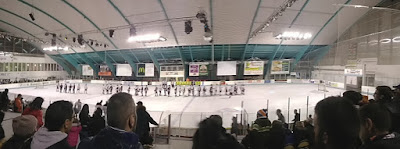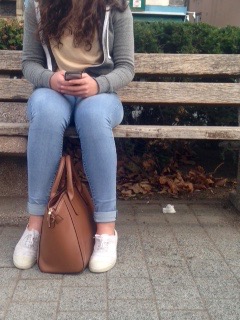Goal!
Fair play
Sport is an important part of urban life, on social,
cultural, economic, and even political levels. To explore this, we went to the ice rink in
Clermont-Ferrand…
The first photo was taken in October 2015. It is in color, though mostly quite dark. We wanted
to show the different kinds of lights, the hockey jerseys and the ads. The viewing
angle is from the tribunes, not too high, not too low so as to be able to see
the match and the environment too. A goal has just been scored. It shows the
solidarity between the players which is really important in a team sport. The
supporters are concentrated on the game. We did not use any effects to take
this picture. We just pointed the camera at the game to take a picture of a
match and show the atmosphere.
The second picture was taken in November 2015 from a different seat. It shows the end of the match, when the
two teams are shaking hands. This is a beautiful moment because this handshake symbolizes
the “fair play” that exists between two teams. All the supporters are clapping and
looking cheerful. They admire the respect both teams show each other after their game. At this moment,
the music is in full swing. We took the picture in panorama mode to show the
width of the ice rink and to show the maximum number of supporters who are all
looking in the same direction.
Both of these pictures were taken in Clermont-Ferrand
on different days. The contrast is created by the two different emotions you see
expressed: the rivalry and the fair play of team sports. Competition can make
you want to do bad things to the opponents, like hurt them in the heat of the
action, but after, at the end of the game, respect returns and the atmosphere
becomes friendly. During the game, the objective is obviously victory, but,
generally, at the end of the match, the tension drops.
In real life, outside the sports arena, you can
express the same feelings; sometimes you do things in a confrontational way, to
become “the best”. It's normal, but you have to be respectful of others
nonetheless. Nowadays, however, these two ways of behaving are no longer always
associated: people live their lives and don't care for others; it's “every man
for himself”. This is particularly true in cities, where people live among lots
of other people. It is usually different in the country, where people tend to be more attentive to
their neighbors...
In a team sport, everyone
cares about his teammates; if someone gets hurt, his teammates will help him. Sports
teams in general are like a family.
At the ice rink, everyone
meets around a wonderful match, people talk about it to their friends, and the
other people go to see the matches. It is a cultural event. There is an
economic aspect too because people pay, obviously.
It was freezing at the matches we attended, but the
ambiance was really warm. If you are not used to watching a hockey match, the
temperature can be surprising, but it's to avoid the ice melting. It was the
beginning of the hockey season. The first match was against the "Français
Volants" team. There was a wonderful home crowd who supported the "Sangliers
Arvernes". The more the team had the hockey puck, the more the supporters
screamed; it was a noisy ambiance but really cool. This sport is brutal; even
the supporters sometimes scream violently at the adverse team. The supporters and
their team form a real union, like a family. All the fans were concentrated on
the match; all were there, together, for the same event. Each time there was a
break, the music played. It reminded us of an American-style show at a basketball
or football match.
On the first picture, in the foreground, there are supporters
sitting on the tribunes (there is a capacity of 1,200). It was an important part
of the match and that is why they are so concentrated. There are window
protections in front of the first row of spectators; the puck can reach 100km/h!
In the middle distance it is the match. The Auvergnats were wearing blue and
orange jerseys and the Parisians black and white. On the left side, are the
bars, and the pump room. We went over there during the break to drink and to
warm up! In the background, you can see where the “outcasts” have to sit, just
under the McDonald's panel. Exclusions are rare; there was no one there at that
moment.
In the second picture, we can see many supporters in
the foreground. The white of the ice rink dominates the picture; it is the central
element of the photograph. The players from the two teams are shaking hands to
congratulate each other on a good match.
Ice hockey became an event at the Olympic Games in
1920. But it is one of the sports which has had difficulties gaining
recognition. This is because of the expensive infrastructure. The Clermont-Ferrand
ice rink was created in 2005. A match is divided in three periods and opposes
two teams of six players. It is impressive because you are not far from the game,
you can see the players up close.
The n° 76 player of the "Sangliers Arvernes"
team is Dusan Brincko. Like most of the team members, he is not from the
region. Dusan comes from the Czech Republic. It is really uncommon to see foreign
players in a small team like ours. Because they are professionals, they train almost
every evening at the ice rink.
We interviewed Dusan. We asked him what difficulties
he had had when arriving in France regarding his job, his friends, his
accommodation, French culture, etc. He is the team captain; his goal is to lead
his team to the "play off" and become champions, at the top of the
ranking. Even if they are professional players, their wages are not sufficient
to live on properly (he is currently looking for a second job). Dusan speaks good
French; this helps him fit in.

































